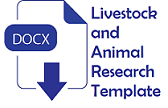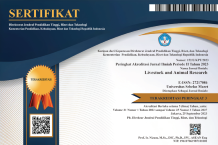Bioinformatic analysis of lucifensin potential as a nutraceutical source for livestock
Abstract
Objective: High number of antibiotic resistance cases in livestock will impact on increasing cases of microbe’s infection. On the other hand, the use of synthetic antibiotics is currently limited. A possible alternative can be used is the utilization of foods that possess medicinal effects (nutraceuticals). The use of animal feed sourced from Diptera larvae has been increasing widely, due to its high protein content. In addition, it is comprised of nutraceuticals as antimicrobial peptides like lucifensin. This study aimed at determining the potential of lucifensin as a nutraceutical product for livestock based on bioinformatics study.
Methods: This study is descriptive research. The lucifensin protein data was obtained from the Protein Data Bank (PDB). The protein relationship analysis was performed using Blast-NCBI and lipinski Rules of 5 (Ro5) analysis to determine its potential as an oral drug (bioavailability). The molecular docking was used Swiss Docking online with lucifensin as target protein and Lipoteichoic Acid (LTAs) of Staphyllococus aureus as ligand.
Results: The relationship analysis results showed that the lucifensin protein was related to two proteins of the other orders of diptera such as phormicin and sapecin. This protein belongs to the defensin protein family in which its coding genes are conserved until the order level. The Ro5 results showed that the mass of lucifensin protein was 312 daltons, its high lippopolycity was -0.5, it has five hydrogen bond donors, six hydrogen bond acceptors, and its molar refractivity was 77.14. Toxicity test also showed that this protein is classified as a safe component, and the docking results illustrate a strong energy bond that plays an important role in antimicrobial activity.
Conclusions: In conclusion, lucifensin protein in the Lucilia sp. larvae is potential to be used as a livestock nutraceutical source that acts as an antimicrobial peptide.
Keywords
Full Text:
PDFReferences
- Friedman, N. D., E. Temkin, and Y. Carmeli. 2016. The negative impact of antibiotic resistance. Clin. Microbiol. Infect. 2(5): 416-22. Doi: 10.1016/j.cmi.2015.12.002
- Zalizar, L., I. D. Rahayu, and Y. A. Nor 2019. Potency of Fibraurea tinctora Lour. extract as anti-bacterial agents towards pathogenic bacteria. IOP Conference Series: Earth and Environ. Sci. 293(1): 12026. Doi: 10.1088/1755-1315/293/1/012026
- Economou, V., and P. Gousia. 2015. Agriculture and food animals as a source of antimicrobial- resistant bacteria. Infect. and Drug Resist. 8:49. Doi: 10.2147/IDR.S55778
- Pruden, A., M. Arabi, and H. N. Storteboom. 2012. Correlation between upstream human activities and riverine antibiotic resistance genes. Environ. Sci. Technol. 46(21): 11541-9. Doi: 10.1021/es302657r
- Zhao, W., B. Wang, and G. Yu. 2018. Antibiotic resistance genes in China: occurrence, risk, and correlation among different parameters. Environ. Sci. Pollut. Res. 25(22): 21467-82. Doi: 10.1007/s11356-018-2507-z
- López-Gálvez, G., M. López-Alonso, A. Pechova, B. Mayo, N. Dierick, and J. Gropp. 2020. Alternatives to antibiotics and trace elements (copper and zinc) to improve gut health and zootechnical parameters in piglets: A review. Anim. Feed Sci. Technol. 271: 114727. Doi: 10.1016/j.anifeedsci.2020.114727
- Chattopadhyay, M. K. 2014. Use of antibiotics as feed additives: a burning question. Front. Microbiol. 5: 334. Doi: 10.3389/fmicb.2014.00334
- Pandey, A. K., P. Kumar, and M. J. Saxena. 2019. Feed additives in animal health. In: Nutraceuticals in veterinary medicine. Springer. p. 345-62. Doi: 10.1007/978-3-030-04624-8_23
- Xia, J., C. Ge, and H. Yao. 2021. Antimicrobial peptides from black soldier fly (Hermetia illucens) as potential antimicrobial factors representing an alternative to antibiotics in livestock farming. Anim. 11(7). Doi: 10.3390/ ani11071937
- Orona-Tamayo, D., M. E. Valverde, and O. Paredes-López. 2019. Bioactive peptides from selected latin american food crops–A nutraceutical and molecular approach. Crit. Rev. Food Sci. Nutr. 59(12): 1949-75. Doi: 10.1080/10408398.2018.1434480
- Rahayu, I. D., W. Widodo, I. Prihartini, A. Winaya, L. Zalizar, T. Untari, and M. Mel. 2019. The potential of extract of Zingiber zerumbet (L.) Smith as a feed additive to improve the production performances and meat nutritional composition of broiler chickens. IOP Conference Series: Earth and Environ. Sci. 293(1): 12023. Doi: 10.1088/17 55-1315/293/1/012023
- Asif, M., and I. Mohd. 2019. Prospects of medicinal plants derived nutraceuticals: A re-emerging new era of medicine and health aid. Prog. Chem. Biochem. Res. 2(4): 150-69. Doi: 10.33945/SAMI/PCBR.2019.4.1
- Rajat, S, S. Manisha, S. Robin, and K. Sunil. 2012. Nutraceuticals: A review. Int. Res. J. Pharm. 3(4): 95-9. Doi: 10.7897/2230-8407
- Keservani, R. K., R. K. Kesharwani, N. Vyas, S. Jain, R. Raghuvanshi, and A. K. Sharma. 2010. Nutraceutical and functional foodas future food: a review. Der Pharmacia Lettre. 2(1): 106-116.
- Rosenbaum, A. J., S. Banerjee, K. M. Rezak, and R. L. Uhl. 2018. Advances in wound management. JAAOS-J. of the American Acad. of Orthop. Surg. 26(23): 833-843. Doi: 10.5435/ JAAOS-D-17-00024
- Pereira, R. F., and P.J. Bartolo. 2016. Traditional therapies for skin wound healing. Adv. wound care. 5(5): 208-29. Doi: 10.1089/wound. 2013.0506
- Čeřovský, V., J. Slaninová, V. Fučík, L. Monincová, L. Bednárová, P. Maloň, and J. Stokrova. 2011. Lucifensin, a novel insect defensin of medicinal maggots: synthesis and structural study. ChemBioChem. 12(9): 1352-61. Doi: 10.1002/cbic.201100066
- Čeřovský, V., and R. Bém. 2014. Lucifensins, the insect defensins of biomedical importance: The story behind maggot therapy. Pharmaceuticals. 7(3): 251-64. Doi: 10.3390/ ph7030251
- Valachova, I., E. Prochazka, J. Bohova, P. Novak, P. Takac, J. Majtan. 2014. Antibacterial properties of lucifensin in Lucilia sericata maggots after septic injury. Asian. Pac. J. Trop. Biomed. 4(5): 358-61. Doi: 10.12980/ APJTB.4.2014C1134
- Ebenebe, C., S. Okweche, O. Okore, V. Okpoko, M. Amobi, J. N. Eze. B. Ezenyilimba, and M. Okonkwo. 2021. Arthropods in Cosmetics, Pharmaceuticals and Medicine: A Review. Arthropods. Doi: 10.5772/intechopen.96159
- Sahoo, A., S. S. Swain, A. Behera, G. Sahoo, P. K. Mahapatra, and S. K. Panda. 2021. Antimicrobial Peptides derived from Insects offer a novel therapeutic option to combat biofilm: A review. Front. Microbiol. 12. Doi: 10.3389/fmicb.2021.661195
- Nygaard, M. K. E., A. S. Andersen, H. H. Kristensen, K. A. Krogfelt, P. Fojan, R. Wimmer. 2012. The insect defensin lucifensin from Lucilia sericata. J. Biomol. NMR. 52(3): 277-82. Doi: 10.1007/s10858-012-9608-7
- Andersen, A. S., D. Sandvang, K. M. Schnorr, T. Kruse, S. Neve, B. Joergensen, T. Karlsmark, and K. A. Krogfelt. 2010. A novel approach to the antimicrobial activity of maggot debridement therapy. J. Antimicrob. Chemother. 65(8): 1646-54. Doi: 10.1093/jac/ dkq165
- Stanchev, S., Z. Zawada, L. Monincová, L. Bednárová, J. Slaninová, and V. Fučík. 2014. Synthesis of lucifensin by native chemical ligation and characteristics of its isomer having different disulfide bridge pattern. J. Pept. Sci. 20(9): 725-35. Doi: 10.1002/psc.2663
- Viljakainen, L. 2015. Evolutionary genetics of insect innate immunity. Brief. Funct. Genom. 14(6): 407–12. Doi: 10.1093/bfgp/ elv002
- Jayaram, B., T. Singh, G. Mukherjee, A. Mathur, S. Shekhar, and V. Shekhar. 2012. Sanjeevini: a freely accessible web-server for target directed lead molecule discovery. In: BMC bioinformatics. Springer. p. 13(7): 1-13. Doi: 10.1186/1471-2105-13-S17-S7
- Lipinski, C. A. 2016. Rule of five in 2015 and beyond: Target and ligand structural limitations, ligand chemistry structure and drug discovery project decisions. Advanced drug delivery reviews. 101(1): 34-41. Doi: 10.1016/j.addr.2016.04.029
- Zhang, H., Y-L. Kang, Y-Y. Zhu, K-X. Zhao, J-Y. Liang, L. Ding, T-G. Zhang, and J. Zhang. 2017. Novel naïve Bayes classification models for predicting the chemical Ames mutagenicity. Toxicol. in Vitro. 41: 56-63. Doi: doi.org/10.1016/j.tiv.2017.02.016
- Kausar, S. H., and V. R. More. 2019. Determination of medium lethal dose (LD50 value) for oral acute toxicity of royal jelly. World J. Pharm. and Pharmaceutical Sci. 8(6): 475-81. Doi: 10.20959/wjpps 2019613954
- Daniel, A. B., J. Strickland, D. Allen, S. Casati, V. Zuang, J. Barroso, M. Whelan, H. Kojima, A. Nishikawa, H-K. Park, J. K. Lee, T. S. Kim, I. Delgado, L. Rios, Y. Yang, G. Wang, and N. Kleinstreuer. 2018. International regulatory requirements for skin sensitization testing. Regulatory Toxicol. Pharmacol. 95: 52-65. Doi: doi.org/10.1016/j.yrtph.2018.03.003
Refbacks
- There are currently no refbacks.










